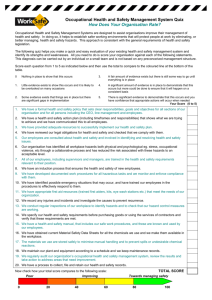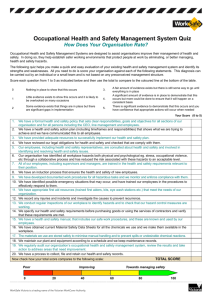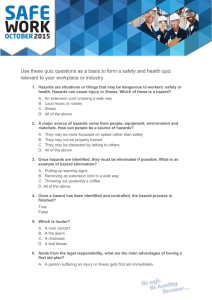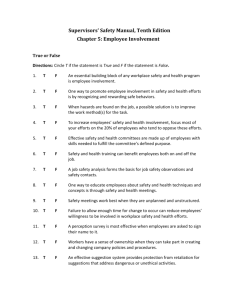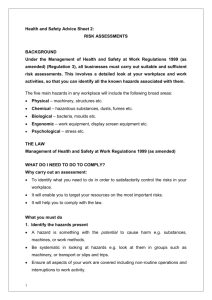PowerPoint
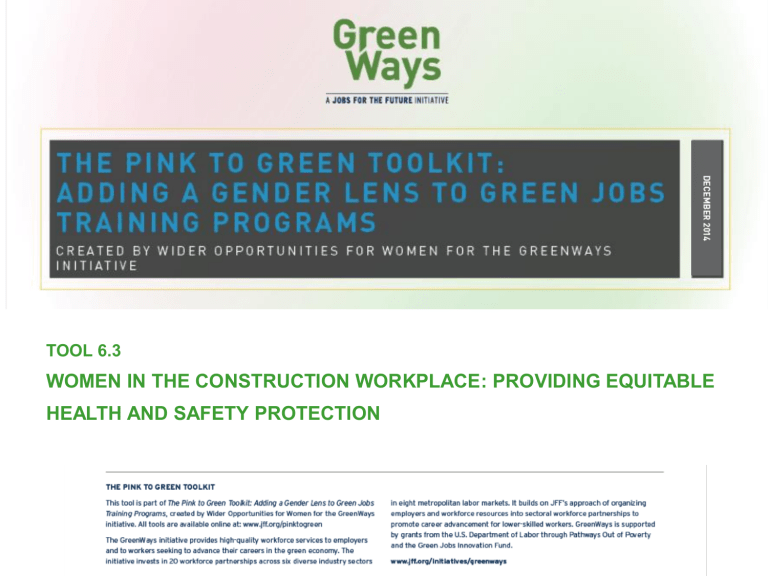
TOOL 6.3
WOMEN IN THE CONSTRUCTION WORKPLACE: PROVIDING EQUITABLE
HEALTH AND SAFETY PROTECTION
LEARNING OBJECTIVES
Students will be able to:
>
Describe why gender matters in health and safety issues in the construction industry
>
Describe how health and safety issues are impacted by gender
>
Describe how issues that are specific to gender can be safety concerns
>
Demonstrate what individuals can do to protect themselves and their coworkers
>
Promote equitable health and safety practices and policies in the workplace
WHY DOES THIS MATTER?
>
Gender inequity and gender differences create distinct health and safety issues for women.
>
The lack of a “gender lens” on health and safety creates disparate impact.
>
Women ’s participation in the industry will continue to grow.
>
The construction industry needs women.
WHY DOES THIS MATTER?
As a female carpenter said,
“The problem is that there’s a mixture of skills you don't have as a woman, and, at the same time, you’re dealing with hostile men. You could deal with the dangerous work if the men treated you right, or you could handle the men if the work wasn’t so dangerous.
It’s the combination that's so hard.”
Source: Chicago Women In Trades (CWIT) 1992
DEPARTMENT OF LABOR REPORT —KEY FINDINGS
>
“In addition to the primary safety and health hazards faced by all construction workers, there are safety and health issues specific to female construction workers.
>
The small percentage of females within the construction trades and the serious health and safety problems unique to female construction workers have a circular effect.
>
Safety and health problems in construction create barriers to women entering and remaining in this field.
>
In turn, the small numbers of women workers on construction worksites foster an environment in which these safety and health problems arise or continue.
”
Source: Report of the DOL OSHA Advisory Committee on Construction Safety and Health 1999
KEY HEALTH AND SAFETY OF WOMEN IN CONSTRUCTION
(HASWIC) ISSUES
>
Sanitary facilities
>
Personal Protective Equipment
>
Ergonomics
>
Workplace culture
>
Reproductive hazards
>
Health and safety training
>
Injury and illness data and research
SANITARY FACILITIES
>
Lack of access
>
Lack of privacy
>
Lack of hygienic conditions
>
>
Leads to urinary tract infections, heat stroke
In CWIT’s report, 80% of tradeswomen have encountered worksites with dirty toilets or no toilets.
>
35% of the women in the second
National Institute of Occupational
Safety and Health (NIOSH) survey answered “false” to the statement,
“There are clean toilets at most jobsites
.”
SANITARY FACILITIES
Needing to leave the jobsite for a sanitary facility can take longer than the allowed break time and can lead to disciplinary action
>
One woman explained that, if a new employee complained about the lack of adequate restroom facilities for women, “You’d see yourself bye-bye.”
>
“When I complained that there was no toilet they transferred me to another jobsite. They took me away from a really good partner and good overtime.
”
Source: CWIT study 1992
SANITATION IS POSSIBLE —AND THE LAW
Toilets at Construction Jobsites
California State Law 1526
>
(a) A minimum of one separate toilet facility shall be provided for each 20 employees or fraction thereof of each sex. Such facilities may include both toilets and urinals provided that the number of toilets shall not be less than one half of the minimum required number of facilities.
>
(b) Under temporary field conditions, not less than one toilet shall be available.
>
(d) Toilet facilities shall be kept clean, maintained in good working order, designed and maintained in a manner which will assure privacy and provided with an adequate supply of toilet paper.
PERSONAL PROTECTIVE EQUIPMENT (PPE)
>
Not properly designed to fit women
’s body sizes
>
“One size fits all” means all men, women’s sizes are not just small men’s sizes
>
Poor fit may mean no fit and unworn PPE
>
Poor fit compromises protection, productivity and long term health
>
Bad fit is a safety hazard
PERSONAL PROTECTIVE EQUIPMENT
Improperly-fitting equipment can mean:
>
Compromised protection —more risk of exposure
>
Difficulty in doing certain tasks (e.g., jobs requiring fine, detailed movements)
>
Working less efficiently: oversized gloves may cause a worker to grasp a tool tighter than she should in order to get a good grip
>
Slower work (muscular fatigue and frequent readjustments of gloves can slow a worker down)
>
Greater number of errors
>
Additional safety risk
PERSONAL PROTECTIVE EQUIPMENT
>
Studies by NIOSH and the U.S.
Department of the Army found that most tools, equipment, and clothing are not designed for a women’s physique.
>
One survey of manufacturers of protective equipment found that only
14% offered ear, head, and face protection in women’s sizes.
When asked if they could easily find protective clothing to fit, 46% of women in the second NIOSH said “no” with respect to work shoes and 41% with respect to finding work gloves.
>
59% of the manufacturers surveyed reported offering foot protection in women’s sizes.
ERGONOMICS
>
Ergonomics describes finding the “best fit” between the worker and the job conditions
>
Goal = worker safety, comfort, and productivity
>
Ergonomic studies assess the interaction of physical abilities and limitations in relation to:
>
Work tasks
>
Tools, equipment, and materials
>
The job environment
>
Ergonomic studies in construction generally evaluated only male workers.
Ergonomic hazards are the most frequently occurring health hazards in construction and the cause of most injuries.
ERGONOMIC HAZARDS: A GENDERED VIEW
Gender differences:
>
Female body size and build require distinct techniques for lifting and handling materials and tools
>
The grips of tools are typically too thick. Tools like pliers require a wide grasp which puts inappropriate pressure on the palm, leading to the loss of functional efficiency
Leads to:
>
Heavy, frequent, or awkward lifting
>
Using excessive force, overexertion
>
Using wrong tools for the job or using tools improperly
>
Awkward grips, postures
ERGONOMIC HAZARDS: A GENDERED VIEW
Photo from NIOSH Pub/CWPR site
>
Tool and equipment size designed for male physique
>
Handle size and tool weight: average hand length of women is 0.8 inches shorter than the average man’s.
Their grip strength averages two-thirds the power of a man’s grip.
>
Female body size and build require distinct techniques for lifting and handling.
>
There is a critical need to increase our knowledge of the
“safe limits” for women for lifting and other motions, such as forward flexion of the trunk (bending over).
Source: Ergonomics for Women in the Trades, Jennifer Hess, DC, MPH, University of
Oregon, LERC
HEALTH AND SAFETY —CONSIDERATIONS FROM BIOLOGICAL GENDER
DIFFERENCES
>
Menstrual cycles influence women ’s bodies
>
Ligaments more stretchy the week prior to period
>
Ligaments get more stiff at the onset of the period
>
Water retention may contribute to carpal tunnel symptoms
>
Knee joint angle (Q angle) greater due to broader hips
>
13
° males, 18° females
>
Knee under slightly more stress
>
Stature
>
Tools and work stations may not be designed for our frames
Source: Ergonomics for Women in the Trades, Jennifer Hess, DC, MPH
University of Oregon, LERC
MALE-DOMINATED WORKPLACE CULTURE
“Women in the construction trade...
can‘t go out there whining...or we can’t go out there and complain. We just have to bite our lip and deal with it if we want to keep our job and if we want to get along with fellow workers.
”
>
Concern with
“fitting in” macho culture may preclude women from using PPE
>
Women may receive less training to do the job correctly due to protectiveness, isolation or hostility
>
Lack of job security, or desire for inclusion in male camaraderie limits hazard reporting or requesting safety equipment or practices
MALE-DOMINATED WORKPLACE CULTURE
52% of the survey respondents in the
CWIT study reported that men refused to work with them during their construction careers
22% of respondents to the CWIT survey had never worked with another woman.
Isolation
—working as the only female on a jobsite or being ostracized by coworkers:
>
Can lead to lack of training, support for handling unsafe conditions and stress
>
Can lead to accidents, unsafe actions
>
Can lead to sexual harassment, assault or placing someone in harm’s way
“When you have more than one woman working with you, you have a better chance. You don’t want to be alone.
The stress is incredible. I had too many illnesses because of that. The more women there are, the more the climate begins to change .”
SEXUAL HARASSMENT —A SAFETY AND HEALTH CONCERN
Sexual harassment leads to:
Stress
Distraction
Assault
Inability to concentrate
Fear
Lack of trust and collaboration
In various studies by NIOSH and CWIT, tradeswomen reported the following experiences with sexual harassment:
>
88% had been confronted with pictures of naked or partially dressed women
>
83% experienced unwelcome sexual remarks
>
57% reported being touched or asked for sex
>
43% had, at some point in their career, experienced uninvited sexually suggestive looks, comments, joking, or gestures from their supervisors
>
72% reported uninvited sexually suggestive looks, comments, joking, or gestures from co-workers
REPRODUCTIVE HAZARDS
>
Physical concerns
>
Biological and chemical exposures
>
Limited research on affect of hazards on women and men
>
Studies have shown that male reproductive organs can be as affected as female
HEALTH AND SAFETY TRAINING
>
Limited skill training or menial assignments can impede safe working practices
>
Culture of workplace (macho/production demand) disdains/discourages attention to safety and Health & Safety training
“Many men don’t want to go to safety meetings. I don’t know if it’s a machismo thing or what. They're getting paid. But then there’s always the contractor or boss breathing down your neck, saying, ‘How come this [work] wasn’t done?’ The boss doesn’t say, ‘You’d better go to that safety meeting because I don't want my workers’ comp bill going up this year .’”
SAFER & HEALTHIER WORK FOR ALL
>
Share information on where to find gender specific PPE and ergonomically designed tools
>
Request a gender specific sanitary facility
>
Encourage coworkers to request clean sanitary facilities and hand-washing on site
>
Ask for modification to equipment to improve ergonomic functioning
THINGS YOU CAN DO TO IMPROVE WOMEN’S HEALTH AND SAFETY ON
THE JOB
>
Attend and engage in safety and health meetings
>
Talk with the staff person responsible for health and safety at your employer on the worksite about your needs
>
Advocate for women’s health and safety on the jobsite
>
Join the union safety committee
>
Share the HASWIC report with your union, employer, and apprenticeship coordinator
SAFER & HEALTHIER WORK FOR ALL
You must take responsibility for your own safety and health, even while expecting your employer, union or apprenticeship program to do their part.
>
Be familiar with OSHA requirements, your company’s health and safety policies
>
Be proactive in collaborating with employer and union on making the workplace safe and healthy for all workers
>
Share your research on how to ensure gender-specific health and safety policy and practice
>
Attend trainings
>
Share the information in this report to back up your requests to address the issues discussed in this module
A SAFER, HEALTHIER WORKPLACE FOR ALL
Everyone benefits when safety and health for women is addressed
>
Better sanitary facilities for all
>
More fit-testing to ensure all workers adequate PPE
>
More respectful and productive workplace
>
Better attention to safety
>
Less adherence to the unsafe practices supported by a “macho” culture
>
Less fear of reprisal for asking for health and safety practices
>
More knowledge about chemical and material health hazards.
